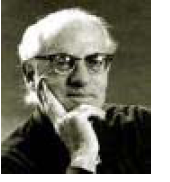Daniel Bell on the Post-Industrial Society
Daniel Bell (1919–) was for much of his career a sociologist who taught at Harvard University and was one of the first to describe what he perceived to be an emerging post-industrial society.

[T]he phrase ‘post-industrial society’ is now used widely [to describe] the extraordinary range of changes that run through the social structure of the emerging post-industrial world, one that does not wholly displace the agrarian and industrial worlds (though it transforms them in essential ways) but represents new principles of innovation, new modes of social organisation, and new classes in society …
The major expansion in contemporary society is ‘human services’, primarily health and education. And both are the chief means today of increasing productivity in society: education by advancing the acquisition of skills, particularly literacy and numeracy; health by reducing illness and making individuals more fit for work … I have broken this area into a further distinction (after the pre-industrial ‘primary’ and the industrial ‘secondary’) of tertiary (transportation and utilities), quaternary (trade and finance), and quinary (health, education, etc.). But for me, the novel and central feature of post-industrial society is the codification of theoretical knowledge and the new relation of science to technology. Every society has existed on the basis of knowledge and the role of language in the transmission of knowledge. But only in the twentieth century have we seen the codification of theoretical knowledge and the development of self-conscious research programs in the unfolding of new knowledge.
Over the course of the last 25 years of the 20th century, he writes in the 1999 foreword to the new edition of his Post-Industrial Society, the following major changes occurred in the United States:
1. From manufacturing to services: Today only 18.8 million Americans, in a workforce of 126 million … [N]early 15 percent of the labour force is now in manufacturing as against 26 percent twenty-five years ago.
2. Occupational changes: The most striking change in the character of work is the extraordinary rise of professional and technical employment and the relative decline of skilled and semi-skilled workers …
3. Property and education: The traditional mode of gaining place and privilege in the society was through inheritance—of a family farm, a family business, or a family occupation … Today education has become the basis of social mobility, especially with the expansion of professional and technical jobs, and even entrepreneurship requires a higher-education background.
4. Financial capital and human capital … In economic theory, until only the past thirty or so years, capital was regarded principally as financial capital amassed as money or land … [H]uman capital is now regarded as an essential feature in understanding the strength of a society … More recently, the concept of social capital [or] … the extent to which one has access to opportunities and social networks …
5. Technology and intellectual technology: [W]hat comes to the fore is ‘intellectual technology’ (based on mathematics and linguistics) which uses algorithms (decision rules), programming (software) models and simulations, in running the new ‘high technology’.
6. Infrastructure: The infrastructure of industrial society was transportation … The infrastructure of the post-industrial society is communication …
7. A knowledge theory of value: An industrial society … is based on a labor theory of value, and the development of industry proceeds by labor-saving devices, substituting capital for labor. Knowledge is the source of invention and innovation. It creates value-added and increasing returns to scale and is often capital-saving.
Bell, Daniel. 1999. The Coming of Post-Industrial Society. New York: Basic Books. pp. x–xi, xiv, xv–xvii. || Amazon || WorldCat
